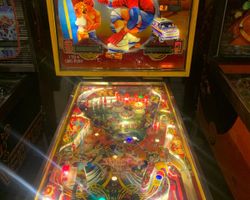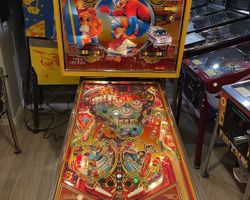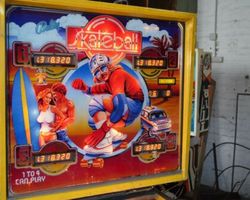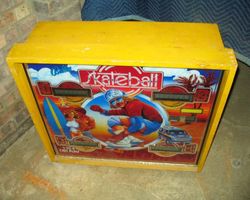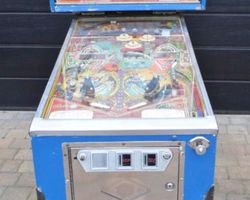Skateball
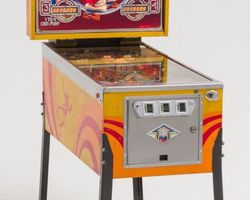
Average Prices: USD $100 to $2,300
Produced: September, 1980
Production Run: 4,150 units
Machine Type: Solid State Electronic
MPU: Bally MPU AS-2518-35
Players: 4
Design by: Claude Fernandez
Art by: Margaret Hudson, Greg Freres, Kevin O'Connor
Skateball by Bally Manufacturing Co., released in September 1980, offers a distinctive glimpse into early solid-state pinball design. The machine draws its theme from the vibrant Californian beach and skate culture of the late 1970s and early 1980s, a period marked by the rise of skateboarding as a mainstream pastime. This pinball machine emerged from a unique genesis, rooted in a previously unproduced Bally model from 1978. Though the original 1978 playfield design for a game also titled ‘Skateball’ was ultimately abandoned, Bally opted to repurpose the striking backglass artwork for the 1980 production run.
The development of Skateball involved a team of talented individuals. Claude Fernandez was responsible for the overall game design, shaping the playfield layout and gameplay objectives. The visual identity, a critical component of any pinball machine, saw contributions from multiple artists. Greg Freres, who had created the backglass art for the unproduced 1978 version, saw his work brought to fruition in this 1980 release. Kevin O'Connor designed the playfield artwork, capturing the dynamic energy of the theme, while Margaret Hudson crafted the plastics that adorned the playfield. The software that brought the game’s rules and scoring to life was programmed by Rehman Merchant. With a production run of 4,150 units, Skateball entered the market as Bally's first solid-state game to feature 7-digit scoring, a technical advancement that allowed for significantly higher scores and more detailed bonus tracking than earlier machines. This technical evolution, combined with its engaging theme, positioned Skateball as a notable entry in the era's pinball landscape.
Signature Features and Design
Skateball distinguishes itself through several unique design choices that collectively shape its gameplay. Foremost among these are its four flippers, a configuration that expands the range of possible shots and demands varied flipper skills from players. Two standard flippers are positioned at the bottom of the playfield, while an additional pair of smaller flippers are strategically placed higher up, opening up shots to specific targets and lanes that would otherwise be inaccessible. Another defining characteristic is the substantial number of drop targets—eleven in total, organized into one five-bank and two three-banks. These targets are central to scoring and objective progression, requiring precision to clear and offering satisfying feedback when struck.
A single spinning target adds a dynamic element to the playfield, providing a high-score opportunity for players who can keep the ball spinning. A kick-out hole, or saucer, serves as a collection point, often rewarding players with points or advancing game features when the ball is captured. Perhaps the most immediately striking feature is the unconventional ball shooter lane. Instead of a traditional path up the side, the shooter directs the ball diagonally across the middle of the playfield to reach the top, setting an immediate and distinct pace from the very first plunge. The aesthetic design is equally impactful. The vibrant artwork, featuring surfers, skateboarders, and beach scenes, immerses players in the theme. The mirrored backglass complements the playfield visuals, creating a cohesive and visually arresting package that stands out on location.
Playfield and Mechanics
The Skateball playfield presents an asymmetrical layout that contributes to its challenging and engaging nature. While a single-level design, its thoughtful arrangement of elements creates a dynamic and fast-paced experience. The aforementioned unique ball shooter propels the ball from the lower right across the central area, aiming for the top lanes, immediately requiring player attention and nudging skill. Once in play, the ball navigates an array of features. The prominent drop target banks are strategically placed, with the five-bank often positioned to be a primary objective, and the two three-banks requiring precision shots from various flippers. Clearing these banks is not merely for points; it frequently lights other features, increases bonus multipliers, or opens access to the kick-out hole.
The three pop bumpers, standard for the era, are positioned in the upper playfield, providing chaotic action and additional scoring. The spinning target is typically located to offer a rewarding shot for skilled players, contributing to points as it rotates rapidly upon impact. A left crossover return lane facilitates flow, allowing the ball to quickly return to the lower flippers after passing through the upper playfield. The general flow of Skateball is lauded for its speed and ability to keep the ball in motion, demanding constant attention and rapid reactions. The artwork across the playfield is meticulously integrated with the gameplay elements, depicting the lively beach and skate scenes. Bright, contrasting colors differentiate targets and pathways, guiding the player's eye. The lighting scheme emphasizes active targets and scoring opportunities, enhancing player immersion and making objectives clear even amidst fast-paced play.
Gameplay Dynamics
Skateball's gameplay dynamics are built around a clear progression of objectives that reward skilled play and strategic thinking. The core mechanics revolve around clearing the various drop target banks, activating the spinning target, and skillfully landing shots into the kick-out hole. Clearing drop target banks is crucial, as this often advances a player's bonus multiplier, a central element of the scoring system. Accumulating a high bonus and then multiplying it before the ball drains is a primary strategy for achieving substantial scores. The four-flipper layout provides enhanced control, allowing players to trap the ball, set up precise shots, and aim for specific targets, fostering a deeper level of engagement than many two-flipper games of the period.
One notable aspect of Skateball's gameplay history involves a specific interaction with the right flipper and inlane. Players discovered that by subtly releasing and pressing the right flipper button while the ball was in the right inlane, they could cause the ball to roll back and forth, rapidly accumulating bonus points. This could lead to a maximum bonus award, often resulting in free games, which posed a challenge for operators concerned with profitability. Operators reportedly implemented various solutions to mitigate this behavior. Despite this, the game’s design encourages a range of player strategies. Mastering the asymmetrical outlanes is essential; the left outlane, for instance, can often be saved with skillful nudging, while the right outlane is known for a challenging post that frequently leads to quick drains, demanding precise control and risk assessment. Successfully making the cross-playfield shots and navigating the target banks while managing the ball's flow defines the rewarding experience of Skateball.
Reception and Legacy
Skateball has garnered a generally positive reception within the pinball community, often described as a "player's game" and a "sleeper classic." Its strengths lie primarily in its surprisingly deep ruleset and engaging gameplay, which reward strategic thinking and precise flipper work. Players often highlight the satisfaction derived from clearing the numerous drop target banks and the varied shot opportunities presented by the four-flipper layout. The game's flow, despite being a single-level design, is frequently praised for being fast and fun, keeping players engaged and eager for "just one more game." The artwork and theme are consistently cited as major draws, with many appreciating the vibrant 1970s/early 1980s Californian beach and skate culture aesthetic, which evokes a strong sense of nostalgia. The unique, almost "brutal" challenge presented by its asymmetrical playfield, particularly the unforgiving right outlane, contributes to its addictive quality and distinguishes it from contemporaries. Enthusiasts often compare Skateball favorably to other popular Bally and Williams machines of its era, finding it holds its own or even surpasses some in terms of layout and player engagement.
However, Skateball is not without its acknowledged weaknesses. The sound package is consistently cited as a drawback, often described as weak, repetitive, or unremarkable when compared to other Bally titles that offered more dynamic audio experiences during the same period. Some players also note the absence of features that became standard in later machines, such as ramps or multiball, though this is typical for early solid-state games. The historical "design flaw" or exploit related to the right flipper and inlane, which allowed for excessive bonus accumulation, remains a point of discussion. While some view it as a curiosity or a challenge to work around, others see it as a flaw that could unbalance scoring. Playfield wear, particularly around the crossover plunger shot and orbit, is another practical concern that requires maintenance. Despite these points, the overwhelming sentiment for Skateball remains highly positive. Its legacy is that of an exceptional example of early solid-state pinball design, celebrated for its innovative features for the time, its deeply engaging rules, and its distinctive visual identity. It stands as a testament to Bally's design prowess in the early 1980s, continuing to be highly regarded by those who appreciate its unique blend of challenge and retro cool.
Sponsored Links
 Ebay Listings
Ebay Listings
 Auction Results
Auction Results
| Cost | Location | Date |
|---|---|---|
| USD $5,500 |  Illinois, United States Illinois, United States |
10 July, 2025 |
| USD $3,500 |  Florida, United States Florida, United States |
07 July, 2025 |
| USD $3,750 |  Florida, United States Florida, United States |
19 May, 2025 |
| USD $4,999 |  Minnesota, United States Minnesota, United States |
24 February, 2025 |
| USD $2,000 |  Illinois, United States Illinois, United States |
27 July, 2023 |
| USD $2,975 |  Minnesota, United States Minnesota, United States |
10 March, 2023 |
| USD $6,495 |  Colorado, United States Colorado, United States |
27 December, 2022 |
| USD $1,800 |  Ohio, United States Ohio, United States |
07 September, 2022 |
| USD $3,500 |  Arizona, United States Arizona, United States |
30 July, 2022 |
| USD $3,500 |  Indiana, United States Indiana, United States |
25 July, 2021 |


Private Policy · Search Website · Contact Us
As an eBay Partner, we may earn a commission from qualifying purchases made through links on this site, at no additional cost to you.
All trademarks and copyrighted materials remain property of their respective owners. All other content copyright 2007 - 2025 Pinpedia.

